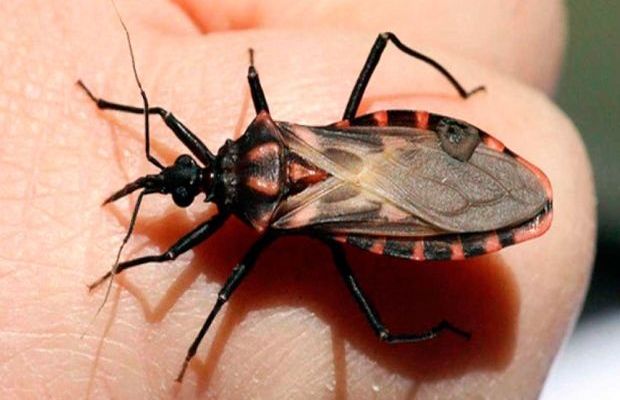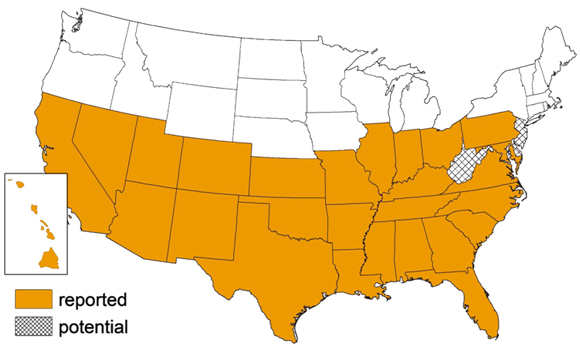 Chagas disease is classified as one of the 17 most important neglected diseases by the World Health Organization. Now, researchers have found that even the non-symptomatic stage of Chagas infection, which can last for many years, more than doubles a person’s risk of death. The new study, published in PLOS Neglected Tropical Diseases, also concludes that deaths from Chagas have likely been under-reported in the past.
Chagas disease is classified as one of the 17 most important neglected diseases by the World Health Organization. Now, researchers have found that even the non-symptomatic stage of Chagas infection, which can last for many years, more than doubles a person’s risk of death. The new study, published in PLOS Neglected Tropical Diseases, also concludes that deaths from Chagas have likely been under-reported in the past.
Chagas disease is an insect-borne parasitic disease caused by Trypanosoma cruzi, also known as the kissing bug, an insect found across half of the United States. A bite from an infected insect initially causes swelling, fever, and headaches, but symptoms are generally mild and fade away after a few months. Infected people often live for decades with no further signs of the disease, during which time medical experts believed there were no further effects. Now new research has revealed that years later, roughly 30% of those infected can develop serious cardiac, digestive, or neurological disorders.
Chagas Spreading to U.S.
Chagas disease is primarily associated with Central and South America, where it is a leading causes of heart failure. Now the disease, and the insect that causes it, are becoming more common across the United States, with a higher percentage of new infections being contracted within the U.S. borders. In Texas, Chagas disease is now diagnosed at higher levels than previously believed, according to researchers from Baylor College of Medicine in Houston. “We were astonished to not only find such a high rate of individuals testing positive for Chagas in their blood, but also high rates of heart disease that appear to be Chagas-related,” said Baylor epidemiologist Melissa Nolan Garcia.
And the problem is not just in Texas – one recent study of 5,000 Latin American-born residents of Los Angeles County has found that 1.24% now test positive for Chagas disease. Additionally, the Centers for Disease Control and Prevention (CDC) have estimated that approximately 300,000 people are living with Chagas in the US.
Increased Risk of “Silent Death”
Less than 1% of infected patients are receiving treatment for Chagas disease, according to Dr. Sheba Meymandi, Director of the Center of Excellence for Chagas Disease (CECD) at Olive View-UCLA Medical Center. “Without treatment many Chagas patients are at risk of a “silent death” due to heart failure. Our study demonstrates the need for similar research in other states, and underscores the critical importance of early detection and treatment to tackle this public health challenge in the US.”
Increased Mortality from Chagas
In another new paper, Ligia Capuani, of the University of Sao Paulo, Brazil, and colleagues studied medical records of 2,842 Chagas-positive and 5,684 Chagas-negative blood donors in Sao Paulo from 1996 to 2000. Since blood donors are routinely screened for symptoms of active Chagas disease, it was assumed that blood samples testing positive for the parasite were from individuals in the indeterminate phase of the disease. Their records were cross-referenced with the Brazil national mortality information system to determine whether each person had died and, if so, the cause of death.
Among those who tested positive for Chagas, 159 (5.6%) died during the course of the study, whereas only 103 (1.8%) who tested negative for the disease died, representing a more than doubling of the overall death risk. Moreover, when only deaths due to Chagas or to underlying cardiac abnormalities were analyzed, the different was even greater – those diagnosed with Chagas disease had a 17.9 time greater risk of death. However, Chagas was often not listed as a cause of death in patients who had tested positive for the disease and died of heart problems.
“The fact that Chagas disease was not reported as an underlying or associated cause of death on the death certificate of 42% of seropositive donors that died due to cardiac causes demonstrates under ascertainment of Chagas disease pathogenesis, highlighting its status as a neglected tropical disease,” the researchers say. “Research is urgently needed in order to test new therapeutic options with fewer side effects and to find better correlates of disease progression.”
Treatment
The only drugs that successfully kill Trypanosoma cruzi parasites are benznidazole and nifurtimox, both more than 40 years old. Presently, neither drug is registered for use in the US by the Food and Drug Administration (FDA).
Boosting access to these drugs and developing newer, better treatments will be critical to any Chagas disease response.
Source: Ligia Capuani, Ana Luiza Bierrenbach, Airlane Pereira Alencar, Alfredo Mendrone, João Eduardo Ferreira, Brian Custer, Antonio Luiz P. Ribeiro, Ester Cerdeira Sabino. Mortality among blood donors seropositive and seronegative for Chagas disease (1996–2000) in São Paulo, Brazil: A death certificate linkage study. PLOS Neglected Tropical Diseases, 2017; 11 (5): e0005542 DOI: 10.1371/journal.pntd.0005542












